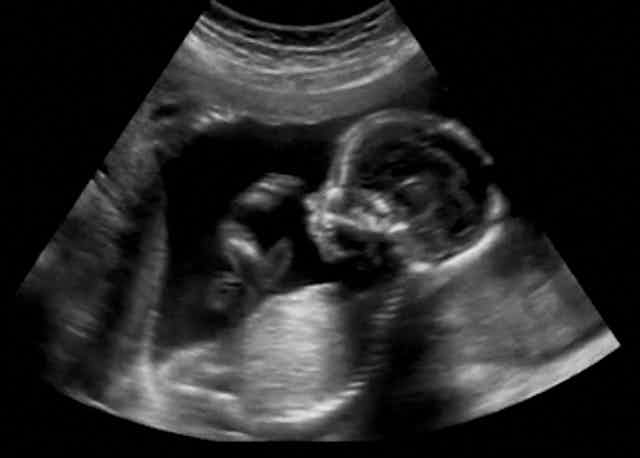Policymakers are tasked with addressing climate change in the face of uncertainty: the 2013 IPCC report projects average global temperatures will increase by anywhere from 5 to 10 degrees Fahrenheit (3 to 6 degrees Celsius) in the coming century if we continue on our path of greenhouse gas emissions.
The uncertainty is compounded by the fact that the consequences of any temperature change are unknown, including how something as basic as human fertility might be affected.
Understanding how climate change will affect fertility is an important economic concern. According to World Bank estimates, in the United States and many European countries, a woman has fewer than two children on average by the end of her reproductive life.
These “below-replacement” birth rates are already putting stress on programs that are funded by the working-age population, like Social Security. Any additional decline in births due to climate change could only make this worse.
Links between temperature and fertility
Global warming might directly affect fertility in two key ways.
First, hot weather could affect sexual behavior. After all, physically demanding activities are more difficult at high temperatures.
Second, temperature could negatively influence reproductive health factors such as sperm motility and menstruation. There are some pretty compelling experimental studies on mammals to support this possibility.

It is these two potential links that led us to hypothesize that global warming might be a threat to human reproduction, something that had yet to be thoroughly investigated by scientists and policymakers.
Our recent NBER study, “Maybe Next Month? Temperature Shocks, Climate Change, and Dynamic Adjustments in Birth Rates,” tests this hypothesis using data on temperature and birth rates from the United States from 1931 to 2010.
The ‘natural’ experiment
Up until recently, there was little consensus regarding temperature’s effect on fertility due to the dearth of experimental evidence. We cannot quantify climate’s role by simply comparing birth rates in “hot” and “cold” places – Louisiana is different from New York in more ways than just weather.
To isolate the effects of temperature, our study relies on a natural experiment: weather fluctuations from year to year in each US state are effectively random. We tested to see if births in Louisiana changed after an unusually hot August.
Our study also controls for many social and economic factors that are changing over time, including economic opportunities for women and access to birth control. While we don’t discount their importance, we were interested in quantifying temperature’s effect above and beyond these other factors.
Hot days and conception chances
We focus on the effects of “hot days,” which we define as days where the average daily temperature is above 80F (27C). Because we averaged the minimum and maximum temperature, the daytime temperature on these days is usually above 90F (32C), which most of us would find to be very hot.
The core finding is that hot days lead to a reduction in birth rates eight to 10 months later. The effect size is largest at nine months: on average, each hot day reduces birth rates nine months later by 0.4% or about 1,100 births. Importantly, the data also show that air conditioning played a major role in minimizing the impact that hot days pose for fertility.
Our study also explores whether the initial decline in birth rates is offset by an increase in the following months. The data show only a partial (32%) “rebound” in birth rates in the three months after the initial decline, possibly due to lingering health effects, work constraints or the natural decline in reproductive health with age. This suggests that these shocks could reduce the number of children a woman has over the course of her reproductive life – a growing concern for the United States and many countries.

As one limitation of our study, we tested for a rebound in births for only up to one year after the initial decline, so there could be some longer-term rebound for which we do not account.
While sexual behavior could certainly be influenced by hot weather, we present some novel evidence to suggest that reproductive health is especially vulnerable. If the story were just about temperature making sex uncomfortable, then we would only see a fall in births eight to nine months later. Instead, we find that birth rates also fall 10 months later, suggesting that hot days have lasting health effects. However, more research is needed to definitively verify this hypothesis.
Fertility costs of climate change
Currently, the United States experiences nearly 30 hot days per year. A prominent global circulation model projects that the United States will experience a tripling of the number of hot days to about 90 by the end of the 21st century.
We project that this warming will cause the number of births to fall by about 107,000 per year by then. There will also be more summer births, due to the rebound, which will expose pregnancies to considerably hotter days during the third trimester and will threaten infant health.
As a caveat, these projections focus exclusively on the fertility cost of heat stress and do not offer insight into the costs of natural disasters or other major social changes resulting from climate change.
Should nothing be done to mitigate climate change, our study indicates that air conditioning can lower the fertility costs. But, we caution that in order to avoid exacerbating climate change, any increase in energy use for air conditioning must be offset with decreases in emissions in other parts of the economy.
While our study offers lessons from the United States, it is uncertain how global warming might impact fertility elsewhere in the world.
Many developing countries, like India, already experience hotter climates than the United States. As a result, these developing countries are more likely to feel the effects of climate change, which could include worse fertility outcomes.
Unfortunately, this is one more area where the costs of climate change are uncertain.

